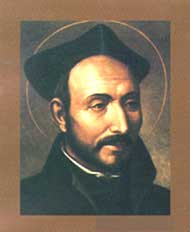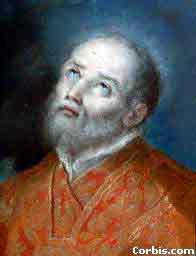Readings:
Genesis 32:22-31
Psalm 22:27-31
1 Corinthians 10:31-11:1
Luke
9:57-62
Preface of a Saint (3)
[Common of a Monastic or Professed Religious]
[Of the Holy Spirit]
PRAYER (traditional language)
Almighty God, who didst call Ignatius of Loyola to the service of thy Divine Majesty and to seek thee in all things; Give us also the grace to labor without counting the cost and to seek no reward other than knowing that we do thy will; through Jesus Christ our Savior, who liveth and reigneth with thee and the Holy Ghost, one God, now and for ever. Amen.
PRAYER (contemporary language)
Almighty God, who called Ignatius of Loyola to the service of your Divine Majesty and to seek you in all things; Give us also the grace to labor without counting the cost and to seek no reward other than knowing that we do your will; through Jesus Christ our Savior, who lives and reigns with you and the Holy Spirit, now and for ever. Amen.
Lessons revised at General Convention 2024.
Return to Lectionary Home Page
Webmaster: Charles Wohlers
Last updated: 9 July 2024
IGNATIUS of LOYOLA
MYSTIC, EDUCATOR, PREACHER, AND FOUNDER OF THE JESUITS (31 JULY 1556)
 Iñigo de Recalde de Loyola, youngest of
thirteen (one of my sources says eleven) children of Don Beltran
Yáñez de Loyola and Maria Sáenz de Licona y Balda, was
born in 1491 in the family castle in the Basque province of Gipozkoa,
in northeastern Spain, near the French border. As befitted a boy
from an aristocratic family, he spent some time as a page at
the court of Ferdinand and Isabella, the rulers of Spain.
Here, by his later testimony, he was involved in gambling, wenching,
and duelling. He got into trouble with the law, but escaped punishment
because he was technically a cleric. (This does not mean that
he was destined for the priesthood. In those days someone becoming
a priest went through
seven steps: doorkeeper, reader, exorcist, acolyte, subdeacon, deacon,
and priest. The first four were called Minor Orders, and did not
involve any serious commitment, but they did make one technically
a cleric, which was useful if one got arrested for anything less
than murder or treason. Probably many young noblemen took the first step
simply as a precaution. Later the law extended the definition of "cleric" to
anyone who could read. See the BIO notes on Thomas a Becket, 29
December.) He then entered military service, but fought in only
one major battle, the defense of Pamplona against the French in
1521. The professional solders knew that their position was indefensible,
and proposed to surrender. Iñigo (or Ignatius, to give him
the Latin form of his name) had visions of military glory, and
urged his comrades to fight. He was promptly hit in the leg by
a cannon ball, the town surrendered anyway, and the French sent
him home on a stretcher.
Iñigo de Recalde de Loyola, youngest of
thirteen (one of my sources says eleven) children of Don Beltran
Yáñez de Loyola and Maria Sáenz de Licona y Balda, was
born in 1491 in the family castle in the Basque province of Gipozkoa,
in northeastern Spain, near the French border. As befitted a boy
from an aristocratic family, he spent some time as a page at
the court of Ferdinand and Isabella, the rulers of Spain.
Here, by his later testimony, he was involved in gambling, wenching,
and duelling. He got into trouble with the law, but escaped punishment
because he was technically a cleric. (This does not mean that
he was destined for the priesthood. In those days someone becoming
a priest went through
seven steps: doorkeeper, reader, exorcist, acolyte, subdeacon, deacon,
and priest. The first four were called Minor Orders, and did not
involve any serious commitment, but they did make one technically
a cleric, which was useful if one got arrested for anything less
than murder or treason. Probably many young noblemen took the first step
simply as a precaution. Later the law extended the definition of "cleric" to
anyone who could read. See the BIO notes on Thomas a Becket, 29
December.) He then entered military service, but fought in only
one major battle, the defense of Pamplona against the French in
1521. The professional solders knew that their position was indefensible,
and proposed to surrender. Iñigo (or Ignatius, to give him
the Latin form of his name) had visions of military glory, and
urged his comrades to fight. He was promptly hit in the leg by
a cannon ball, the town surrendered anyway, and the French sent
him home on a stretcher.
The leg was badly set, and did not heal properly. It had to be rebroken and reset, and again it healed crookedly and left him with a permanent limp. Meanwhile, he was bedridden for many months, and spent the time reading. He asked for tales of knightly adventure, but instead was given a Life of Christ, written by a Carthusian monk. He read it, and his life was transformed. He went on pilgrimage to Montserrat (near Barcelona), where he hung up his sword over the altar, and then spent about a year at Manresa near Montserrat first working as a nurse and orderly in a hospital there, and then retiring to a cave to live as a hermit and study The Imitation of Christ, by Thomas a Kempis, a book urging the Christian to take Christ as example, and seek daily to follow in His footsteps. It is probably during this year that he wrote his Spiritual Exercises, a manual of Christian prayer and meditation. He directs the reader to begin with an event in the life of Christ, and to imagine the scene in detail, to replay the episode in his mind like a movie script, and to try to feel as if he had himself witnessed the event, and then to use this experience as a motive for love, gratitude, and dedication to the service of God. The book is available today in hardcover and paperback. It has been much used by Christians of all varieties--John Wesley was enthusiastic about it. Ignatius then made a pilgrimage to Jerusalem to see with his own eyes the scenes of Our Lord's life and death. He wanted to stay and preach to the muslims, but the Franciscans stationed there advised him that he needed an education in order to preach effectively.
 Back
in Spain, he spent ten years (1524-1534) getting an education at Barcelona,
Alcala, Salamanca, and Paris, beginning by going to elementary school
to learn Latin grammar, and ending with a Master of Arts degree from the
University of Paris. In Salamanca, he often preached to groups of people
assembled by chance; but in those days a layman undertaking to preach
on his own, without a license or supervision, was automatically suspected
of heresy. Ignatius was twice imprisoned by the Spanish Inquisition and
questioned about his beliefs, an experience that made a deep impression
on him. (He was finally acquitted, but forbidden to discuss religious
matters for three years.) Today, his followers are aggressively proud
of the fact that no member of their order has ever sat on an Inquisitorial
tribunal. (It is possible that Ignatius already had doubts about the Inquisition.
He was a Basque, and I am told that the Inquisition was never active in
Biscay because the Basques, although thoroughly orthodox Christians, would
not tolerate it.) In 1534, he and six fellow students formed a group who
vowed to travel to Jerusalem and there preach the Gospel to the moslems.
(The most famous of the six is Francis Xavier, who went to India and China
as a missionary, and who is commemorated on 3 December.) This group later
took the name, "The Society of Jesus," and were nicknamed "the Jesuits"
by outsiders, a nickname that stuck.
Back
in Spain, he spent ten years (1524-1534) getting an education at Barcelona,
Alcala, Salamanca, and Paris, beginning by going to elementary school
to learn Latin grammar, and ending with a Master of Arts degree from the
University of Paris. In Salamanca, he often preached to groups of people
assembled by chance; but in those days a layman undertaking to preach
on his own, without a license or supervision, was automatically suspected
of heresy. Ignatius was twice imprisoned by the Spanish Inquisition and
questioned about his beliefs, an experience that made a deep impression
on him. (He was finally acquitted, but forbidden to discuss religious
matters for three years.) Today, his followers are aggressively proud
of the fact that no member of their order has ever sat on an Inquisitorial
tribunal. (It is possible that Ignatius already had doubts about the Inquisition.
He was a Basque, and I am told that the Inquisition was never active in
Biscay because the Basques, although thoroughly orthodox Christians, would
not tolerate it.) In 1534, he and six fellow students formed a group who
vowed to travel to Jerusalem and there preach the Gospel to the moslems.
(The most famous of the six is Francis Xavier, who went to India and China
as a missionary, and who is commemorated on 3 December.) This group later
took the name, "The Society of Jesus," and were nicknamed "the Jesuits"
by outsiders, a nickname that stuck.
In 1537 the Jesuits (now ten in number) gathered in Venice and (having
found that renewed war in Palestine made journeying there impossible) offered
their services to Pope Paul III. Ignatius and some of the others were ordained
to the priesthood, and they were assigned various tasks. In 1540 they became
a formal organization, with the usual monastic vows, plus a fourth vow
of personal obedience to the Pope. In order to have more time for preaching
and study the order abolished the practice (followed by almost all previous
orders) of reciting the monastic Hours in community. Its chief goals were:
(a) renewal of the Roman Catholic Church through
extensive education and the encouragement of frequent use of the sacraments,
(b) extensive missionary work in non-Christian
countries, and
(c) a suitable response to the growing challenge
of Protestantism.
In the remaining fifteen years of his life, Ignatius supervised the Jesuits from Rome and saw the order grow from ten men to a thousand. It was always active in missions, and became deeply involved in education, and in counselling those with difficult decisions to make, particularly rulers. The Order undertook to win back to the Roman obedience those areas that had recently become Protestant. Ignatius counselled his Jesuits (technically neither monks nor friars, but priests regular) to proceed with charity and moderation, "without hard words or contempt for people's errors." He died suddenly on 31 July 1556. His writing include the following prayer:
Teach us, good Lord, to serve thee as thou
deservest;
to give, and not to count the cost,
to fight, and not to heed the wounds,
to toil, and not to seek for rest,
to labor, and not to ask for any reward,
save that of knowing that we do thy will.